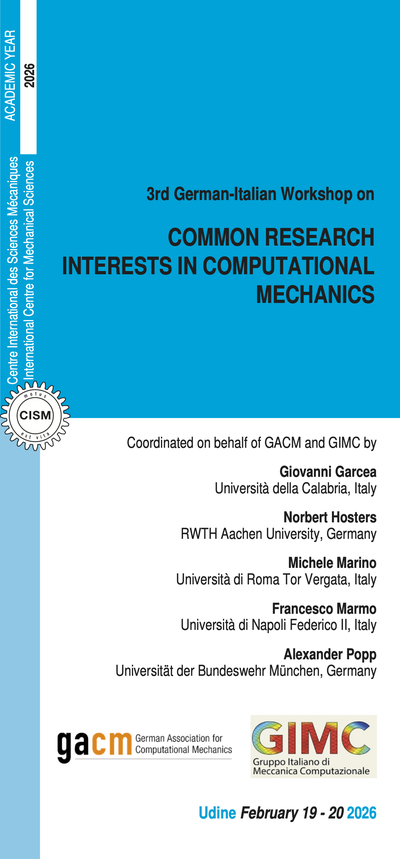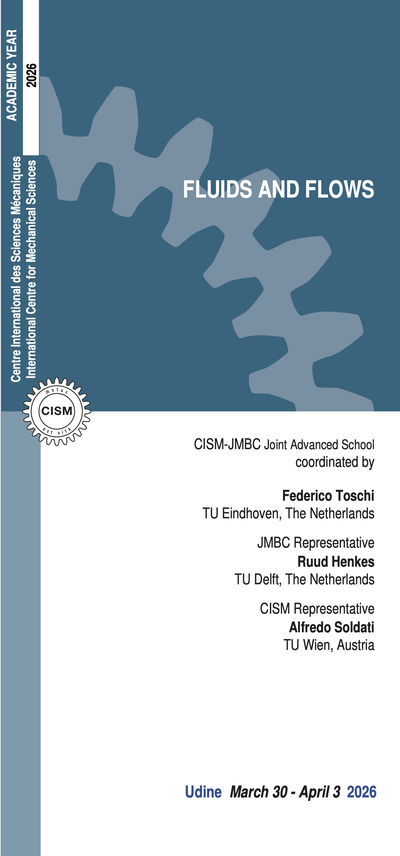Current developments in mechatronics lead to (and often require) the integration of sensors and actuators in mechanical structures. This trend is represented by research topics as for instance “smart structures” and “structural health monitoring”. The associated technologies connect mechanics with neighboring disciplines such as electrical engineering and microtechnology. The design of audio electrodynamic loudspeakers will serve as an example for a particular application treating the FE-modeling of the devices, their verification by prototypes, and their application as loudspeakers in cars.
For the realization of embedded transducers, microtechnologies are particularly useful which will be introduced by Prof. Lina Sarro. Microsystems or MicroElectroMechanical Systems (MEMS) technology covers design, technology and fabrication efforts aimed at combining electronic functions with mechanical, optical, thermal and others and that employ miniaturization in order to achieve high complexity in a small space. The core technologies, silicon bulk micromachining and surface micromachining, will be introduced to illustrate the potential of 3D micro structuring in the development of Microsystems. Advances in dry etching technology and thin films deposition and the added value the introduction of other materials in silicon-based technology offer, will be discussed as well.
When implementing autonomous sensor nodes, energy harvesting technologies are essential to power these nodes, which will be discussed by Prof. Vittorio Ferrari. Energy harvesting to power sensors from the surroundings, making them autonomous nodes, or passive sensors with energy supplied on demand from an external interrogation module, are two attractive options, each with specific features. Both options can be enabled by piezoelectric elements embedded in miniaturized devices. The lectures will introduce the piezoelectric effect as a cross-domain energy conversion mechanism and offer an overview of principles and applications in stand-alone sensors.
Prof. Michiel Vellekoop will discuss microfluidic components and systems. The investigation and analysis of fluids in microchips should, compared to macro devices, yield advantages such as very small sample volumes, high speed testing, integration of multiple functions, and monitoring of fast reaction dynamics. In the course, some fundamentals of fluid behavior are used to discuss basic design considerations for microfluidic devices. Technologies for the realization of microfluidic devices, which are partly very different from standard sensor technology will be presented. In addition, some attention will be given to the “chip to world” connection, as it is an important aspect that is often underexposed. Finally, a series of examples of Lab on a Chip devices will be conferred.
Prof. Bernhard Jakoby will provide general considerations when considering interaction of vibrating systems with liquids. First, some fundamental principles regarding microacoustic devices will be reviewed and selected microacoustic sensors will be discussed as examples. Many of these devices require special analysis approaches to allow for efficient modeling. To understand and model the interaction with fluids, the behavior of potentially non-Newtonian fluids will be considered including a discussion on the first and second coefficient of viscosity. The interaction with fluids will be considered for piezoelectrically and electromagnetically actuated devices and device performance and modeling will be discussed for selected examples.
Finally, the sensing and control of deformations and stresses in structures will be addressed by Prof. Hans Irschik. Particular emphasis will be given to dense, specially weighted piezoelectric sensor networks that can measure, e.g., discrete displacements or slopes. The use of so called nil-potent sensor networks for structural health monitoring will be discussed. Complementary to the discussion on sensors, weighted piezoelectric actuator networks that can track desired displacement fields, as well as nil-potent actuator networks and their usage for minimizing the actuator input energy will be presented. As a quite new research field, structural control of stresses by dense piezoelectric sensor and actuator networks will be systematically addressed also in the lectures.
H. Bruus, Theoretical Microfluidic, Oxford University Press, Canada, 2007.
G. Hairer, M.J. Vellekoop, An integrated flow-cell for full sample stream control, Microfluid Nanofluid, 7:647-658, 2009, DOI 10.1007/s10404-009-0425-6.
M. Krommer, H. Irschik, Sensor and actuator design for displacement control of continuous systems, Smart Structures and Systems, Vol. 3, No. 2, 147-172, 2007.
H. Irschik, M. Krommer, Y. Vetyukov, On the Use of Piezoelectric Sensors in Structural Mechanics: Some novel strategies, Sensors, 10 (6), 5626-5641, 2010.
R. Lerch, G. Sessler, D. Wolf, Technische Akustik Grundlagen und Anwendungen, Springer-Verlag Berlin Heidelberg, 1st ed. 2009, ISBN: 978-3-540-23430-2.
R. Lerch, Elektrische Messtechnik Analoge, digitale und computergestützte Verfahren, Springer-Verlag Berlin Heidelberg, 7th ed. 2016, ISBN: 978-3-662-46940-8.
P.P.L. Regtien, Piezoelectric sensors in Sensors for Mechatronics, Elsevier, Amsterdam (NL), Ch. 8, 219-239, 2012, ISBN: 978-0-12-391497-2.
V. Ferrari, Printed thick-film piezoelectric and pyroelectric sensors, in Printed films: Materials science and applications in sensors, electronics and photonics M. Prudenziati and J. Hormadaly (Eds.), Woodhead Publishing Limited, Cambridge (UK), Ch. 9, 221-258, 2012, ISBN: 978 1 84569 988 8.
V. Ferrari, R. Lucklum, Overview of Acoustic-Wave Microsensors, in Piezoelectric Transducers and Applications 2nd edition, A. Arnau Vives Ed., Springer-Verlag Berlin Heidelberg, 39-62, 2008, ISBN: 978-3-540-77507-2.
M. Madou, Fundamentals of Microfabrication and Nanotechnology, 3rd ed., CRC Press, 2011.
G. T. A. Kovacs et al., Bulk micromachining of silicon, Proc. IEEE, vol. 86, no. 8, pp. 1536-1551, 1998.
J. M. Bustillo et al., Surface micromachining for microelectromechanical systems, Proc. IEEE, vol. 86, no. 8, pp. 1552-1574, 1998.
F. Herrmann, B. Jakoby, J. Rabe, and S. Büttgenbach, Microacoustic sensors for liquid monitoring, Sensors Update, 9(1), 105-160, 2001.
B. Jakoby, M.J. Vellekoop, Physical sensors for liquid properties, IEEE Sensors Journal 11.12, pp.3076-3085, 2011.
6 lectures on: Piezoelectric transducers and energy harvesting: fundamentals of piezoelectric transducers, readout electronics for transducers, electromechanical transducers for energy harvesting.
6 lectures on: Feed-forward control of stresses and deformations in structures by piezoelectric transducers: fundamentals of structural shape control, displacement and stress tracking, nilpotent sensors and actuators, health monitoring by distributed sensors.
6 lectures on: Fluidic Sensors and Actuators: fundamentals of fluidic sensors, physical fluid properties, physical chemosensors, sensors for rheological, thermal and electric fluid properties, sensor design and fabrication.
6 lectures on: Micromechanical transducers and systems: introduction to micromachining of miniaturized mechatronic systems (MEMS), fabrication technologies, design rules, device and application examples.
6 lectures on: Microfluidic components and systems: fundamentals of microfluidics, Lab on a Chip devices, opto-fluidic concepts and structures, technology for integrated fluidic devices.
The registration fee is 600.00 Euro + VAT*, where applicable (bank charges are not included). The registration fee includes a complimentary bag, four fixed menu buffet lunches (on Friday upon request), hot beverages, downloadable lecture notes and wi-fi internet access.
Applicants must apply at least one month before the beginning of the course. Application forms should be sent on-line through the following web site: http://www.cism.it. A message of confirmation will be sent to accepted participants. Applicants requiring assistance with the registration should contact the secretariat at the following email address cism@cism.it.
Applicants may cancel their course registration and receive a full refund by notifying CISM Secretariat in writing (by email to cism@cism.it) no later than two weeks prior to the start of the course.
Cancellation requests received during the two weeks prior to the start of the course will be charged a 50.00 Euro handling fee. Incorrect payments are also subject to a 50.00 Euro handling fee.
A limited number of participants from universities and research centres who are not supported by their own institutions can be offered lodging and/or board, if available, in a reasonably priced hotel or student guest house.
Requests should be sent to CISM Secretariat by July 9, 2019 along with the applicant's curriculum and a letter of recommendation by the head of the department or a supervisor confirming that the institute cannot provide funding. Preference will be given to applicants from countries that sponsor CISM.
Information about travel and accommodation is available on the web site www.cism.it, or can be mailed upon request.
* Italian VAT is 22%.





